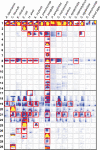Ion mobility spectrometry for microbial volatile organic compounds: a new identification tool for human pathogenic bacteria
- PMID: 22327321
- PMCID: PMC3605498
- DOI: 10.1007/s00253-012-3924-4
Ion mobility spectrometry for microbial volatile organic compounds: a new identification tool for human pathogenic bacteria
Abstract
Presently, 2 to 4 days elapse between sampling at infection suspicion and result of microbial diagnostics. This delay for the identification of pathogens causes quite often a late and/or inappropriate initiation of therapy for patients suffering from infections. Bad outcome and high hospitalization costs are the consequences of these currently existing limited pathogen identification possibilities. For this reason, we aimed to apply the innovative method multi-capillary column-ion mobility spectrometry (MCC-IMS) for a fast identification of human pathogenic bacteria by determination of their characteristic volatile metabolomes. We determined volatile organic compound (VOC) patterns in headspace of 15 human pathogenic bacteria, which were grown for 24 h on Columbia blood agar plates. Besides MCC-IMS determination, we also used thermal desorption-gas chromatography-mass spectrometry measurements to confirm and evaluate obtained MCC-IMS data and if possible to assign volatile compounds to unknown MCC-IMS signals. Up to 21 specific signals have been determined by MCC-IMS for Proteus mirabilis possessing the most VOCs of all investigated strains. Of particular importance is the result that all investigated strains showed different VOC patterns by MCC-IMS using positive and negative ion mode for every single strain. Thus, the discrimination of investigated bacteria is possible by detection of their volatile organic compounds in the chosen experimental setup with the fast and cost-effective method MCC-IMS. In a hospital routine, this method could enable the identification of pathogens already after 24 h with the consequence that a specific therapy could be initiated significantly earlier.
Figures




References
-
- Barbuddhe SB, Maier T, Schwarz G, Kostrzewa M, Hof H, Domann E, Chakraborty T, Hain T. Rapid identification and typing of Listeria species by matrix-assisted laser desorption ionization–time of flight mass spectrometry. Appl Environ Microbiol. 2008;74:5402–5407. doi: 10.1128/AEM.02689-07. - DOI - PMC - PubMed
Publication types
MeSH terms
Substances
LinkOut - more resources
Full Text Sources
Other Literature Sources
Medical
Molecular Biology Databases
Research Materials

